Wednesday,June 25,2025. Annette’s Roundup for Democracy.
Despite Trump’s boasts and bluster, his bombs did not do the job.
Strike Set Back Iran’s Nuclear Program by Only a Few Months, U.S. Report Says
Classified findings indicate that the attack sealed off the entrances to two facilities but did not collapse their underground buildings.
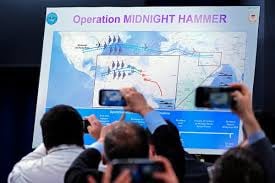
Reporters photographing a display for “Midnight Hammer,” the name of the American operation to bomb Iran’s nuclear sites, during a news conference on Sunday.
A preliminary classified U.S. report says the American bombing of Iran’s nuclear sites sealed off the entrances to two of the facilities but did not collapse their underground buildings, according to officials familiar with the findings.
The early findings conclude that the strikes over the weekend set back Iran’s nuclear program by only a few months, the officials said.
Before the attack, U.S. intelligence agencies had said that if Iran tried to rush to making a bomb, it would take about three months. After the U.S. bombing run and days of attacks by the Israeli Air Force, the report by the Defense Intelligence Agency estimated that the program was delayed less than six months.
Former officials said that any rushed effort by Iran to get a bomb would be to develop a relatively small and crude device. A miniaturized warhead would be far more difficult to produce, and it is not clear how much damage to that more advanced research has taken place.
The findings suggest that President Trump’s statement that Iran’s nuclear facilities were obliterated was overstated, at least based on the initial damage assessment. Congress had been set to be briefed on the strike on Tuesday, and lawmakers were expected to ask about the findings of the assessment, but the session was postponed. Senators are now set be briefed on Thursday.
The report also said much of Iran’s stockpile of enriched uranium was moved before the strikes, which destroyed little of the nuclear material. Some of that may have been moved to secret nuclear sites maintained by Iran.
Some Israeli officials said they also believe that Iran has maintained small covert enrichment facilities that were built so the Iranian government could continue its nuclear program in the event of an attack on the larger facilities.
Officials cautioned that the five-page classified report is only an initial assessment, and others will follow as more information is collected and as Iran examines the three sites at Fordo, Natanz and Isfahan. One official said that the reports people in the administration had been shown were “mixed” but that more assessments were yet to be done.
But the Defense Intelligence Agency report indicates that the sites were not damaged as much as some administration officials had hoped, and that Iran retains control of almost all of its nuclear material, meaning if it decides to make a nuclear weapon it might still be able to do so relatively quickly.
Officials interviewed for this article spoke on the condition of anonymity because the findings of the report remain classified.
The White House took issue with the assessment. Karoline Leavitt, a White House spokeswoman, said it was “flat-out wrong.”
“The leaking of this alleged assessment is a clear attempt to demean President Trump, and discredit the brave fighter pilots who conducted a perfectly executed mission to obliterate Iran’s nuclear program,” she said in a statement. “Everyone knows what happens when you drop 14 30,000-pound bombs perfectly on their targets: total obliteration.”
Elements of the intelligence report were reported earlier by CNN.
The strikes badly damaged the electrical system at Fordo, which is housed deep inside a mountain to shield it from attacks, officials said. It is not clear how long it will take Iran to gain access to the underground buildings and then repair the electrical systems and reinstall equipment that was moved.
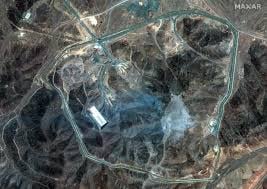
A satellite image provided by Maxar Technologies of the Fordo nuclear site.Credit.Maxar Technologies, via Associated Press.
Initial Israeli damage assessments have also raised questions of the effectiveness of the strikes. Israeli defense officials said they have also collected evidence that the underground facilities at Fordo were not destroyed.
Before the strike, the U.S. military gave officials a range of possibilities for how much the attack could set back the Iranian program. Those ranged from a few months on the low end to years on the higher end.
Some officials cautioned that such estimates are imprecise, and that it is impossible to know how long Iran would exactly take to rebuild, if it chose to do so.
Mr. Trump has declared that B-2 bombing raids and Navy Tomahawk missile strikes “obliterated” the three Iranian nuclear sites, an assertion that Defense Secretary Pete Hegseth repeated at a Pentagon news conference on Sunday.
But Gen. Dan Caine, the chairman of the Joint Chiefs of Staff, has been more careful in describing the attack’s effects.
“This operation was designed to severely degrade Iran’s nuclear weapons infrastructure,” General Caine said that at the Sunday news conference.
The final battle damage assessment for the military operation against Iran, General Caine said on Sunday, standing next to Mr. Hegseth, was still to come. He said the initial assessment showed that all three of the Iranian nuclear sites that were struck “sustained severe damage and destruction.”
At a Senate hearing on Monday, Democrats also struck a more cautionary note in challenging Mr. Trump’s assessment.
“We still await final battle damage assessments,” said Senator Jack Reed of Rhode Island, the senior Democrat on the Armed Services Committee.
Military officials had said that to do more significant damage to the underground sites, they would have to be hit with multiple strikes. But Mr. Trump announced he would stop the strikes after approving the first wave.
U.S. intelligence agencies had concluded before the strikes that Iran had not made the decision to make a nuclear weapon, but possessed enough enriched uranium that if it decided to make a bomb, it could do so relatively quickly.
While intelligence officials had predicted that a strike on Fordo or other nuclear facilities by the United States could prompt Iran to make a bomb, U.S. officials said they do not know yet if Iran would do so.
Representatives of the Defense Intelligence Agency did not respond to requests for comment. (New York Times).
One more thing.
There’s a great deal of agreement on Trump’s failure.
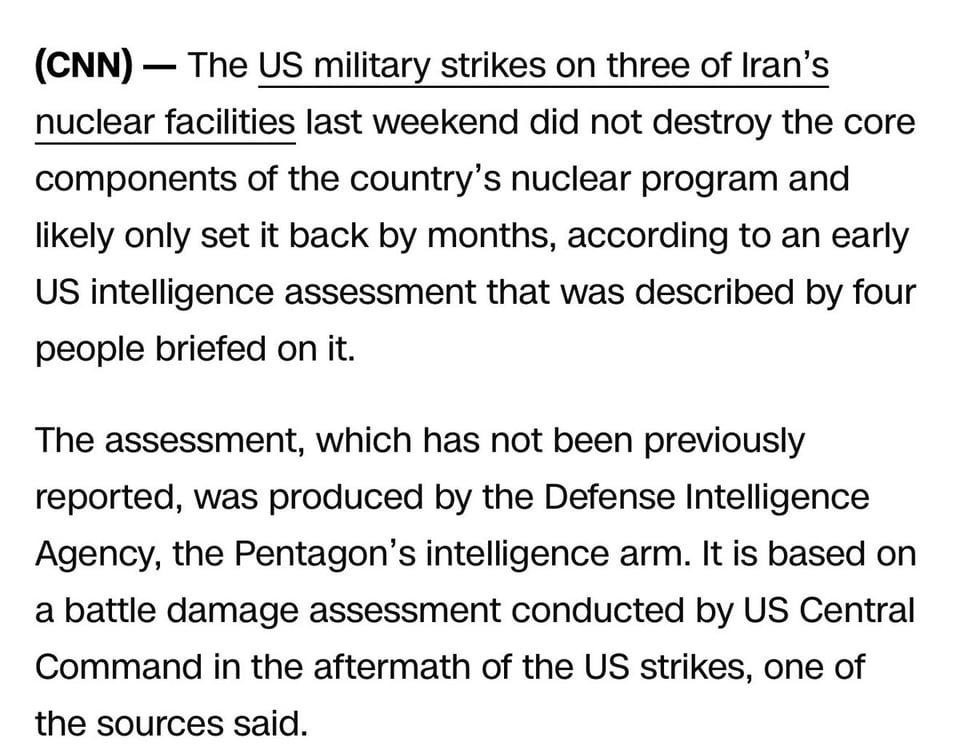
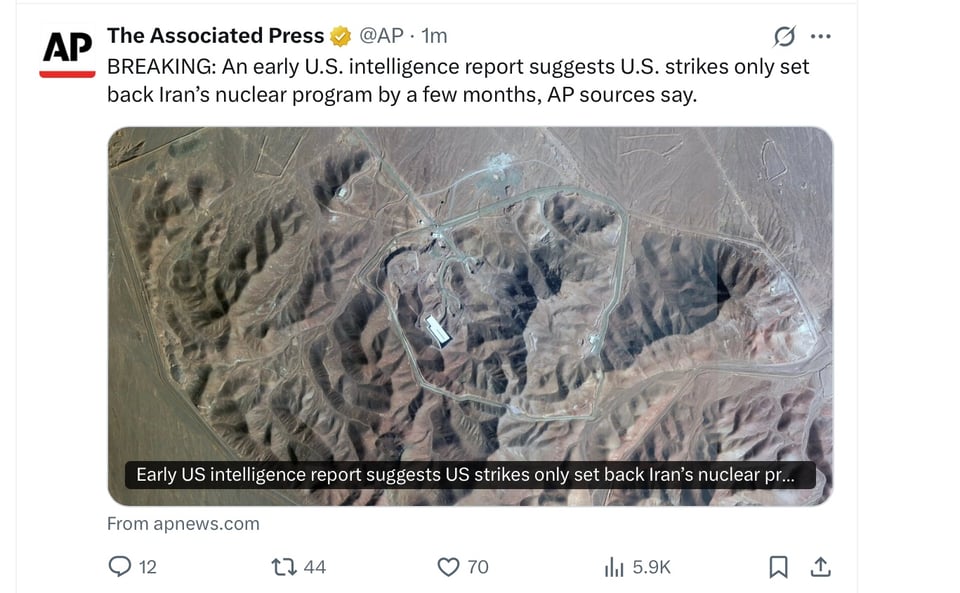
Hey, surprise! This guy was mad.👇
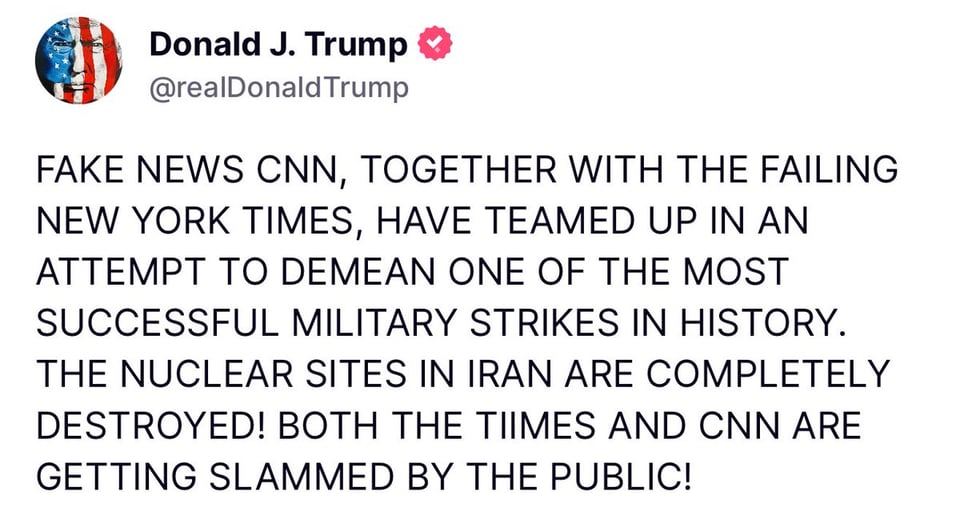
Before the report making clear that the Trump attack failed, President Biden’s Secretary of State weighed in.
He makes good points.
Antony Blinken: Trump’s Iran Strike Was a Mistake. I Hope It Succeeds.

The strike on three of Iran’s nuclear facilities by the United States was unwise and unnecessary. Now that it’s done, I very much hope it succeeded.
That’s the paradox for many former officials like me who worked on the Iran nuclear problem during previous administrations. We shared a determination that Iran never be allowed to produce or possess a nuclear weapon. Iran without a nuclear weapon is bad enough: a leading state sponsor of terrorism; a destructive and destabilizing force via its proxies in Lebanon, Syria, Gaza, Yemen and Iraq; an existential threat to Israel. An Iran with a nuclear weapon would feel emboldened to act with even greater impunity in each of those arenas.
So why was the strike a mistake?
First, it never should have come to this. In 2015, the Obama administration, together with Britain, France, Germany, Russia, China and the European Union, reached agreement with Tehran on the Joint Comprehensive Plan of Action, or J.C.P.O.A. The nuclear deal effectively put Iran’s program to make fissile material, the fuel for a nuclear weapon, in a lockbox, with stringent procedures for monitoring Iran’s nuclear program. The deal pushed “breakout” — the amount of time it would take Iran to produce enough weapons-grade uranium for a single nuclear weapon — to at least one year. If Iran reneged on the agreement or refused to extend it when certain provisions expired after 15 years, we would know it and have plenty of time to respond, including, if necessary, militarily.
In 2018, President Trump tore up the agreement and replaced it with … nothing. In response, Iran accelerated its enrichment, quite likely reducing its breakout time to a matter of days or weeks.
>Mr. Trump, in essence, is now trying to put out a fire on which he poured gasoline.
Second, fissile material is a necessary but insufficient element for a bomb. You also need an explosive weapon. As of now — and there are conflicting messages coming from within the Trump administration — our intelligence agencies believe Iran has not yet made a decision to weaponize. If and when it does, it would take Tehran 18 to 24 months to produce an explosive device, according to some estimates. In other words, there was still time for diplomacy to work, and the situation wasn’t nearly the emergency that Mr. Trump portrayed it to be.
Third, experts I’ve spoken to had real doubts about the ability of the Massive Ordnance Penetrator, or M.O.P. — the 30,000-pound bombs unique to America’s arsenal that were dropped on Iran’s nuclear sites — to fully incapacitate the Fordo site and other deeply buried or fortified components of Iran’s nuclear program. Initial reports suggest that while Iran’s nuclear infrastructure was severely damaged, it was not destroyed.
Fourth, in war-gaming the military option during my time in the Biden administration, we were also concerned that Iran had or would spread its stockpile of uranium already enriched to just short of weapons grade to various secure sites and preserve enough centrifuges to further enrich that stockpile in short order. In that scenario, the Iranian regime could hide its near weapons-grade material, green light weaponization and sprint toward a bomb. Thus, Mr. Trump’s strike has risked precipitating what we want to prevent. In this, it may prove a repeat of Israel’s strike against Iraq’s Osirak reactor in 1981 — after the strike, Saddam Hussein accelerated an underground program.
Finally, while there is no doubt the American strike set back Iran’s nuclear ambitions, Iran could rebuild quickly, in locations and at depths virtually immune to airstrikes, while pursuing weaponization at the same time. So while their program has been significantly disrupted, and buying time is a good thing, it underscores that sticking with the J.C.P.O.A. was the better option. It bought us at least 15 years instead of just a few. And it avoided the risk of Iranian retaliation — such as Monday’s missile attacks directed at our forces in the region — as well as the potential for further escalation, including threatening global oil flows through the Strait of Hormuz, conducting terrorist operations on American soil or carrying out sophisticated cyberattacks.
And, perhaps paradoxically, Mr. Trump’s actions were possible only because of the work of the Obama and Biden administrations.
The Obama administration accelerated development of the M.O.P. and had contingency plans for the type of operation that Mr. Trump authorized. Mr. Biden instructed his team to rehearse, test and refine those plans. We also conducted, in 2023, the largest-ever joint exercise with Israel — something of a dry run for this latest action.
As important, Mr. Biden supported Israel’s successful efforts to grievously weaken Iran and its proxies. Our deployments, deterrence and active defense of Israel when Iran directly attacked it for the first time allowed Israel to degrade Iran’s proxies and its air defenses without a wider war.
In so doing, we set the table for Mr. Trump to negotiate the new nuclear deal he pledged years ago to work toward — or to strike. I wish that he had played out the diplomatic hand we left him.
Now that the military die has been cast, I can only hope that we inflicted maximum damage — damage that gives the president the leverage he needs to finally deliver the deal he has so far failed to achieve. (Antony J. Blinken was the secretary of state under President Joe Biden,New York Times Op-Ed).
Do you think AOC gets to Trump? Or is he worrying about his 3rd impeachment? Or Both?

AOC answered. Quite smartly, I think.

Zohran Mamdani will be the Democratic Nominee for Mayor.

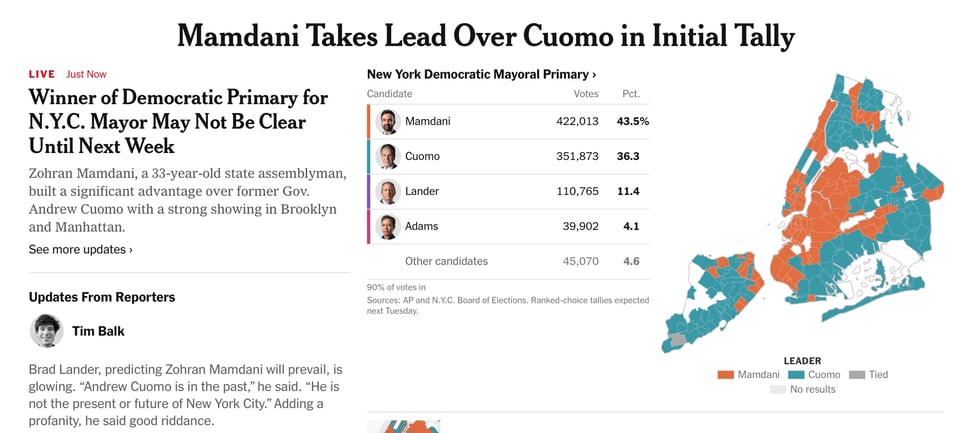
Ranked voting is complicated, and Mamdani didn’t win it in the first round but that Lander plus Adrienne Adams vote will put him over the top to get him over 50% in the next round (unless the 15.5% of the people who voted for Lander and Adrienne Adams put Cuomo, not Mandami second - and that is unlikely).
From Perplexity AI app,
• First-round threshold: If no candidate receives more than 50% of the first-choice votes, the ranked-choice elimination process begins.
• Elimination rounds: The candidate with the fewest first-choice votes is eliminated, and their voters’ ballots are reallocated to their next-ranked choices. This continues in rounds until only two candidates remain, and the one with the majority wins.
• Final result: If Mamdani is still short of 50% after the first round (with 43.5%), the elimination process continues, and the winner is determined only after all ranked-choice rounds are completed and all ballots are counted—this could take several weeks due to mail-in and affidavit ballots.
Brad Lander’s request from his supporters is why we know Mamdani will win when the voting is done. 👇

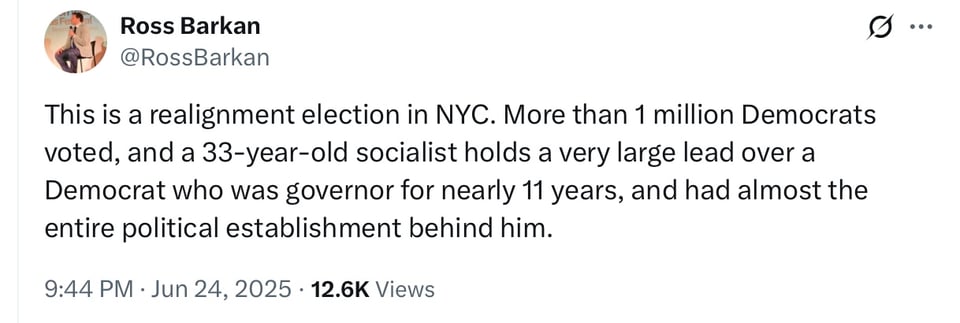
One more thing.

Alvin Bragg, the Manhattan prosecutor who successfully led the election interference case which resulted in 34 felony convictions against Donald Trump, won the Democratic primary in his bid for second term as Manhattan District Attorney.
___________________________________________